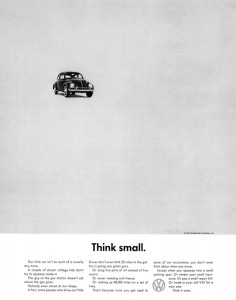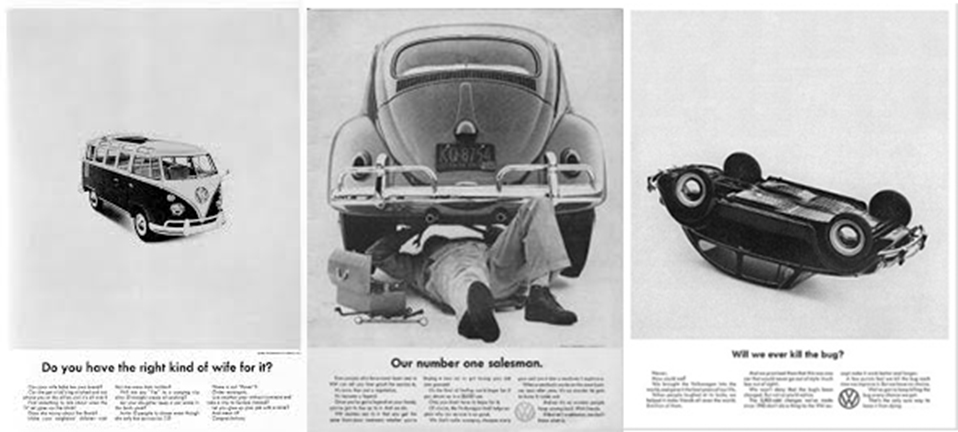By: C. Justin Hall
DDB’s Think Small Campaign:
There have been many recognizable ad campaigns over the past century, from Norelco’s television ads with santa sledding down the hill to the red and yellow M&M’s but “one campaign did much more than boost sales and build a lifetime of brand loyalty. It’s the 1960s ad campaign for the Volkswagen Beetle. The ad, and the work of the ad agency behind it, changed the very nature of advertising–from the way it’s created to what you see as a consumer today” (Odgen). The “Think Small” campaign was developed in 1959 for advertising the Volkswagen Beatle. Conceived by Helmut Krone and Julian Koenig, this campaign is what many consider to be one of the best advertising schemes of the 20th century. “Think Small” was an exercise in minimalism and thus a very accurate reflection on the product itself.
“Fifteen years after World War II, the United States had become a world and consumer superpower; and cars began to be built for growing families with Baby Boomer children and “Americans obsessed with muscle cars”. The Beetle, a “compact, strange-looking automobile”, was manufactured in a plant built by the Nazis in Wolfsburg, Germany, which was perceived to make it more challenging to sell the vehicle (being that the car was designed in Nazi Germany). Automobile advertisements focused on providing as much information as possible to the reader instead of persuading the reader to purchase a product, and the advertisements were typically rooted more in fantasy than in reality.” (Kabourek) The “Think Small” ads were different.
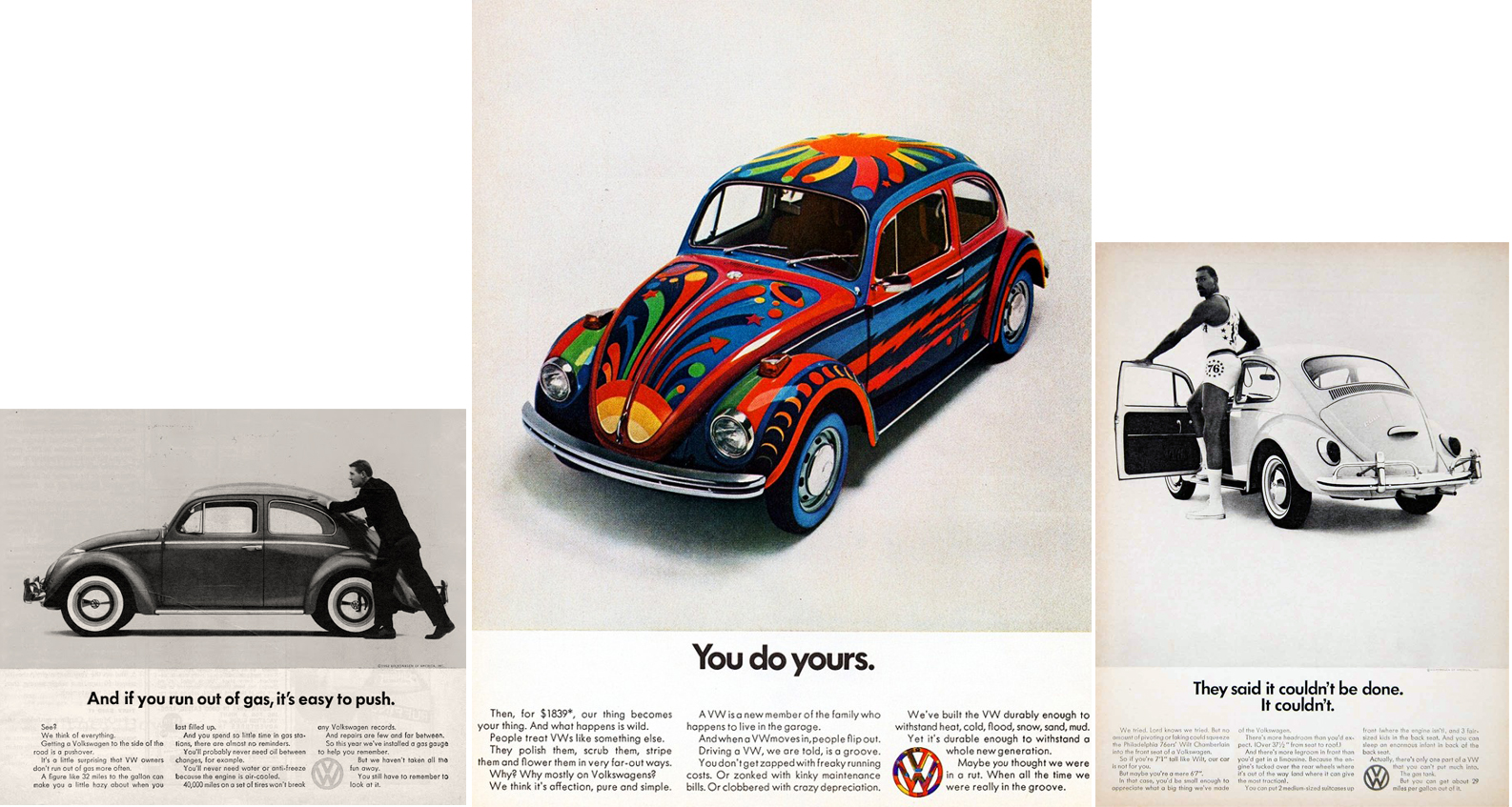
The Creative Revolution:
These advertisements were considered a success in part because they sold a lot of cars, but what really set in stone their success was how they turned the marketing world on its head. Considered by the industry to be groundbreaking, this, along with some other advertising techniques of the time, ushered in a new wave of marketing dubbed the “Creative Revolution.” This new era in marketing schemes attempted to associate the product being advertised with an idea or way of living. Companies were no longer just trying to sell consumers a product, now they were trying to sell a lifestyle. (Mathew) This was quite a change from previous campaigns of the century where marketers attempted to “motivate” consumers into purchasing their product boasting that said product was a type of status symbol. “Beetle ownership allowed you to show off that you didn’t need to show off” (Garfield)
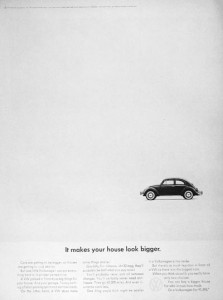 The ads placed a small car inside of what appeared to be a gigantic, solid-colored room. Written in fine print at the bottom of the page, billboard, or screen, Krone and Koenig wrote about the advantages of owning a smaller vehicle in an attempt to lure consumers away from luxury automobiles. By laying out a page primarily with negative space, the readers’ eyes are immediately drawn to the small car. The use of negative space, or “white space”, in graphic design is something that has always fascinated me. Defined simply as the “portion of a page left unmarked: margins, gutters, and space between columns, lines of type, graphics, figures, or objects drawn or depicted.” (Wikipedia et al.) Negative space is what allows the subject matter on the page to exist. When used improperly it can cause a design to look unfinished or incomplete, but when used properly, as is the case in the “Think Small” ads, it draws the viewer’s eye to the objects the designer wants to be seen.
The ads placed a small car inside of what appeared to be a gigantic, solid-colored room. Written in fine print at the bottom of the page, billboard, or screen, Krone and Koenig wrote about the advantages of owning a smaller vehicle in an attempt to lure consumers away from luxury automobiles. By laying out a page primarily with negative space, the readers’ eyes are immediately drawn to the small car. The use of negative space, or “white space”, in graphic design is something that has always fascinated me. Defined simply as the “portion of a page left unmarked: margins, gutters, and space between columns, lines of type, graphics, figures, or objects drawn or depicted.” (Wikipedia et al.) Negative space is what allows the subject matter on the page to exist. When used improperly it can cause a design to look unfinished or incomplete, but when used properly, as is the case in the “Think Small” ads, it draws the viewer’s eye to the objects the designer wants to be seen.
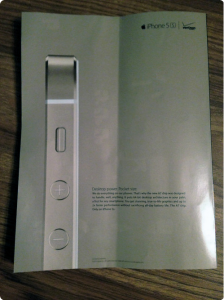
This type of aesthetic is just as important today as it has ever been. “More and more these days, the creative world is seeing an emergence of artists creating positive spaces and shapes that, in turn, cleverly carve out shapes in negative space intentionally. And the results can be stunning.” (Hughes & Kitney) A fairly recent example of this is with the direction Apple has been going in with some of the newer products they have been advertising. A fairly recent example of this is with the direction Apple has been going in with some of the newer products they have been advertising. As seen in the example above, Apple mimics the older Volkswagen ads with their use of minimal color, minimal text, and the perfect amount of negative space.
After the almost overnight success of the first few printed ads for this campaign, Helmut Krone and Julian Koenig continued pushing out advertisement in the same style as the original.
Ned Doyle, Maxwell Dane and Bill Bernbach, better known as DDB & Co, the American advertising firm responsible for Think Small, is still in existence today and going as strong as ever. Established in 1949 DDB & Co. “gave the advertising industry a wake-up call. They introduced a new approach to marketing that relied on insight into human nature, respect for the consumer, and the power of creativity. In short, they said; “Let’s stop talking at people and instead start conversations that lead to action and mutual benefit.” (Bernbach et al.) DDB & Co. created six of the 100 greatest ad campaigns of all time, according to Ad Age and work with brand giants like McDonalds, Honda, Volkswagen, and M&M’s, just to name a few. The majority of the advertisements the company creates use what is known as a “soft-sell” approach. Unlike other marketing campaigns that use boldness, exclusivity and repetition, “soft-sell” is more likely to use catchy slogans or witty humor. DDB & Co. wants the products it sells to seems approachable and within reach to the average person.
_________________________________________________________________________
Citations:
Bernbach, Bill, Ned Doyle, and Mawell Dane. “DDB Worldwide.” . DDB Worldwide Communications Group Inc, 1 Jan. 1949. Web. 29 Apr. 2014. <http://www.ddb.com/>.
Garfield, Bob. Ad Age Advertising Century: Top 100 Campaigns”. adage.com. Crain Communications Inc. March 29, 1999. Web 22 Apr. 2014 < http://adage.com/article/special-report-the-advertising-century/ad-age-advertising- century-top-100-campaigns/140918/>
Hughes , and Kitney. “.” . Future Publishing Limited, 22 Jan. 2014. Web. 27 Apr. 2014. <http://www.creativebloq.com/art/art-negative-space-8133765>.
Kabourek, Sarah. “Game-changing ads”. CNN. 4 Aug. 2009. Web 22 Apr. 2014 < http://money.cnn.com/galleries/2009/fortune/0908/gallery.iconic_ads.fortune/>
Mathew , Robin. “How The Way We Make Ads Was Changed Forever.” . Life In CMYK, 2 Sept. 2011. Web. 29 Apr. 2014. <http://lifeincmyk.wordpress.com/2011/02/09/think- small-or-how-the-way-we-make-ads-was-changed-forever%E2%80%A6/>.
Odgen, Mike, “Top ad campaign of century? VW Beetle, of course” Portland Business Journal. 1999. Web. 29 Apr. 2014. http://www.bizjournals.com/portland/stories/1999/11/15/smallb4.html
Wikipedia contributors. “White space (visual arts).” Wikipedia, The Free Encyclopedia. Wikipedia, The Free Encyclopedia, 27 Mar. 2014. Web. 29 Apr. 2014.
